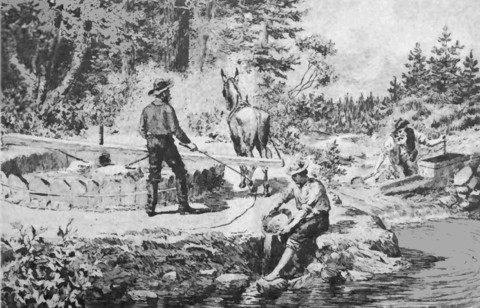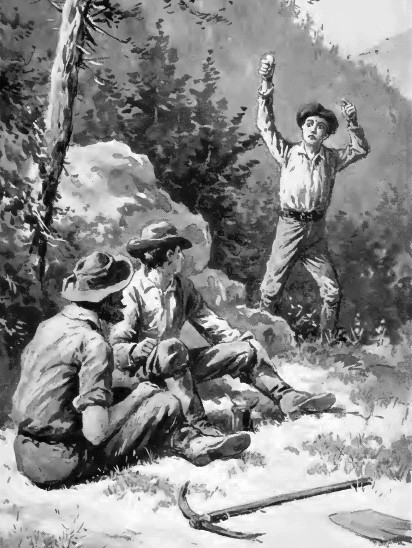The first discoveries, as we have seen, were made on the Gila about twenty miles from the Colorado, where gold placers were opened in 1858 and caused something of a gold rush, A traveler passing at that time said he saw twenty dollars washed out of: eight shovels full of dirt; this in the rudest manner by an unpracticed hand. The diggings were located in sand hills from a half a mile to a mile from the river, and there being no water at hand, dry washing was resorted to by the Indians and Mexicans, who made from one to two dollars a day, and occasionally secured twenty to thirty dollars. About this time the Eureka District was located above what is now the city of Yuma, where a vein of argentiferous galena carrying from twenty to thirty percent silver with a small amount of native gold, was discovered. These lodes were in the mountain ranges from one to twenty miles east from the river bank, and were reached by trails. A few of them were taken up in 1862, and at that time were partially developed.
Castle Dome, fifty miles above Yuma City, so called from its being located upon this isolated mountain resembling a dome, was laid out about this time. The lodes were in the mountains fifteen to thirty miles back from the river, but were not easy of access, and water was very scarce. The ores were argentiferous galena in a vein stone of fluorite, and contained from thirty to forty ounces to the ton. For years afterwards they were extensively worked and some of them proved quite profitable. The next district was that above the town of La Paz, and bore the same name. It was first explored in the Colorado River gold rush excitement of 1862. Mr. A. McKey, a member of the Territorial Legislature from La Paz, furnished to J. Ross Browne, the annexed account of the discovery of the placers that caused the building of La Paz, which became a place of considerable importance and a favorite shipping point for goods for Central Arizona, and, although I have heretofore alluded to these diggings, yet it may not be out of place to insert at this point the statement of Mr. MeKey, which is as follows: "Captain Pauline Weaver, and others, in the month of January, 1862, were trapping on the Colorado River, and at times would stray off into the mountains for the purpose of prospecting for gold ores. They had discovered what was then named and is still called 'El Arollo de la Tenaja,' which is about two miles north from El Campo Ferra, and about seven miles east from La Paz. In this gulch they had discovered gold in small quantities, and had taken out two or three dollars' worth, which Captain Weaver kept in a goose-quill.
"Soon after this discovery Weaver visited Fort Yuma and exhibited what gold he had. This evidence of the existence of a commodity so much sought for in this country convinced others that gold might be found in quantities by hunting for it. Don Jose M. Redondo having heard of; the discovery, at once set out to visit the newly found 'El Dorado,' in company with several others. He arrived a few days afterward at the camp of Captain Weaver, who pointed out to him and his party the particular gulch from which he had taken the gold. After a short examination of this place the party set out in different directions to discover, if possible, something which would pay to work, and the extent of the placers. Within less than a mile from Weaver's camp, south, Redondo took a pan of dirt to prospect, and when he had dry washed it, to the astonishment of himself and the party with him, they found that he had one 'chispa' which weighed two ounces and one dollar, besides other small pieces. Others of his party found good prospects, but none of the company had come for anything more than to ascertain the truth or falsity of the reported glad tidings and therefore were not prepared to remain and work for want of the necessary provisions and tools, but were compelled to return to La Laguna, a settlement some twenty miles above Fort Yuma, on the Arizona side of the Colorado.
After their arrival at La Laguna, and report of what they had discovered, a party of forty persons prepared to visit the new mines. After their arrival in the placers, about the middle of February, 1862, discoveries were made almost daily, until it was known that every gulch and ravine for twenty miles east and south was rich with gold. Ferra Camp, Campo en Medio, American Camp, Los Chollos, La Plomosa, and many other smaller places, all had their rich diggings, but the discovery made by Juan Ferra, of the Ferra Gulch, was, without doubt, the most valuable of any. Very soon the knowledge of these discoveries spread to Sonora and California, and people began to pour in from all points, and continued to come until they probably numbered fifteen hundred.
This population was maintained to a greater or less extent until the spring of; 1864, when the apparent exhaustion of the placers and the extreme high prices for provisions caused large numbers to leave. The discovery of the Weaver and Walker diggings in the year 1863, drew away many of the miners from these placers. "Of the yield of these placers, anything like an approximation to the average daily amount of what was taken out per man would only be guesswork. Hundreds of dollars per day to the man was common, and now and again a thousand or more per day. Don Juan Ferra took one nugget from his claim which weighed 47 ounces and six dollars. Another party found a 'chispa' weighing 27 ounces, and another one of 26 ounces. Many others found pieces of from one or two ounces up to 20, and yet it is contended that the greater proportion of the larger nuggets were never shown for fear of some evil spirits, who infested the mines at the time. It is the opinion of those most conversant with the first working of: these placers, that much the greater proportion of the gold taken out was in nuggets weighing from one dollar up to the size of the 'chispas' above named. I have often heard it said of those days that 'not even a Papago Indian would work for less than $10 per day.' "As has been seen from the above, the gold was large and generally clear of foreign substances.
The largest piece (above mentioned) did not contain an apparent atom of quartz or any other base matter. The gold from the different camps varied a trifle in its worth at the mint in San Francisco, and brought from $17.50 to $19.50 per ounce. But all that was sold or taken out here went for from $16 to $17 per ounce. Since the year 1864 until the present, there have been at various times many men at work in these placers, numbering in the winter months hundreds, but in the summer months not exceeding 75 or 100 ; and all seem to do sufficiently well not to be willing to work for the wages of the country, which are and have been for some time, from $30 to $65 per month and found. No inconsiderable amount of gold comes in from these placers now weekly, and only a few days ago I saw, myself, a nugget which weighed $40, clear and pure from any foreign substances. ' Some parties have lately come into these diggings with what is called concentrators or dry washers, which they have been working for a few weeks, and in conversation with Mr. Finkler (an owner of one of these machines) he told me that he could make $20 per day where he was at work, and pay three dollars per day for his hands, and that he only required four to work the machine. Should these machines prove a success these placers will soon be peopled again with industrious, prosperous miners. Of the total amount of gold taken from these mines, I am as much at a loss to say what it has been as I was to name the average daily wages of the first years, and as I might greatly differ from those who were among the first in these mines, I do not feel justified in setting up an opinion as against them; I shall, therefore, give the substance of the several opinions which I have obtained from those who were the pioneers of these placers. I have failed to find any one of them whose opinion is that less than $1,000,000 were taken from these diggings within the first year, and in all probability as much was taken out within the following year."
In 1863 what was known as the Planet Mine was discovered by one Ryland, who, in 1864, organized a company in San Francisco. This was a copper mine, and the second copper mine discovered in the Territory. It was worked from 1865 up to 1873, the selected copper ore being shipped to San Francisco and there sold at a hundred dollars a ton. The mine was located twelve miles from the Colorado, and within a mile from Bill Williams' Fork. It was not until 1862 and 1863 that an attempt was made to thoroughly explore Central Arizona. Whipple and Beale, as we have seen, had crossed on the 35th parallel. Aubrey and Leroux had seen something of the Verde River and the northern tributaries of the Gila, but no one had attempted more than a hurried trip through the country, although all believed it rich in precious metals.
Return
to The Arizona Page:
Arizona Gold Rush Mining History



